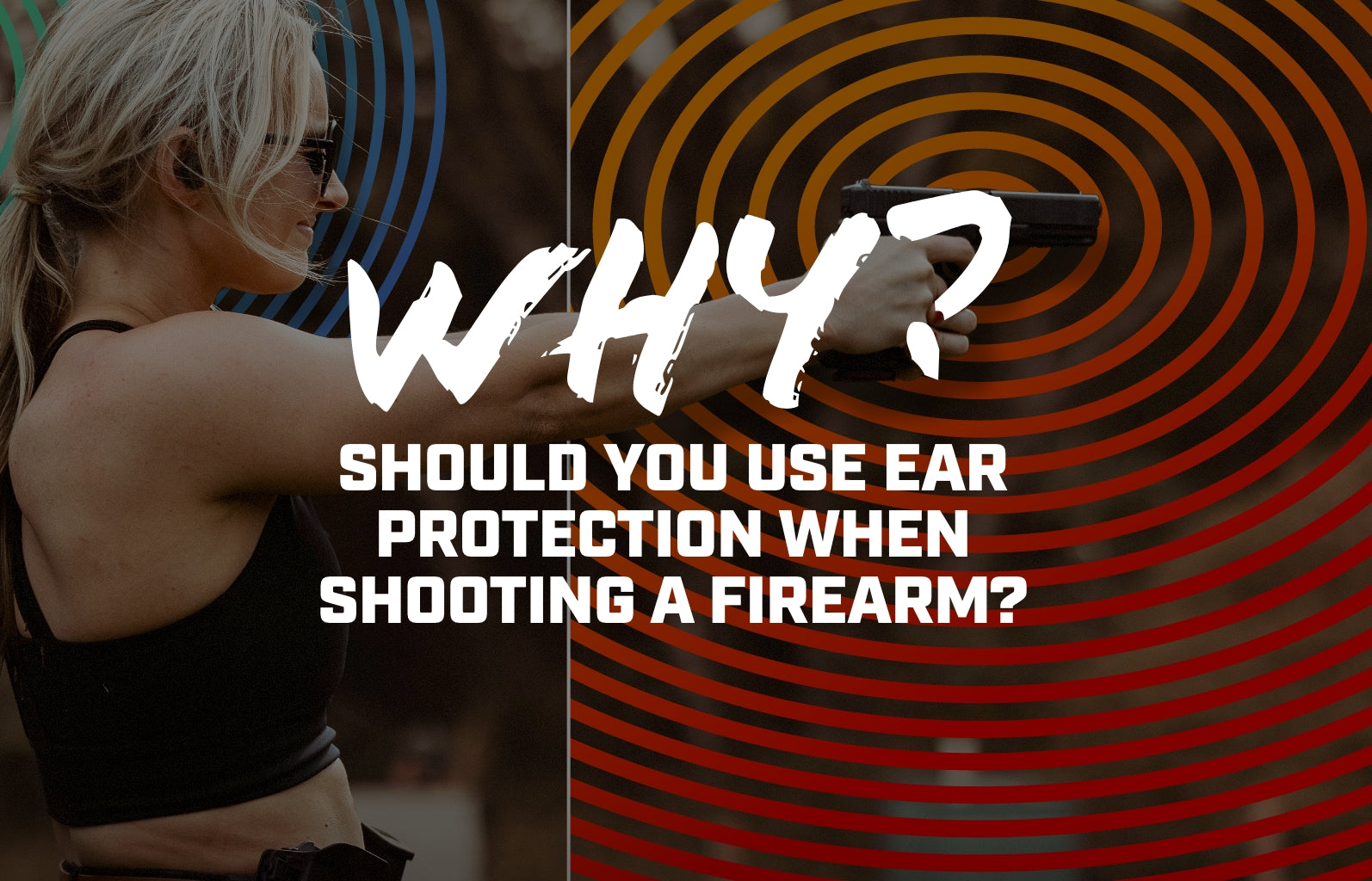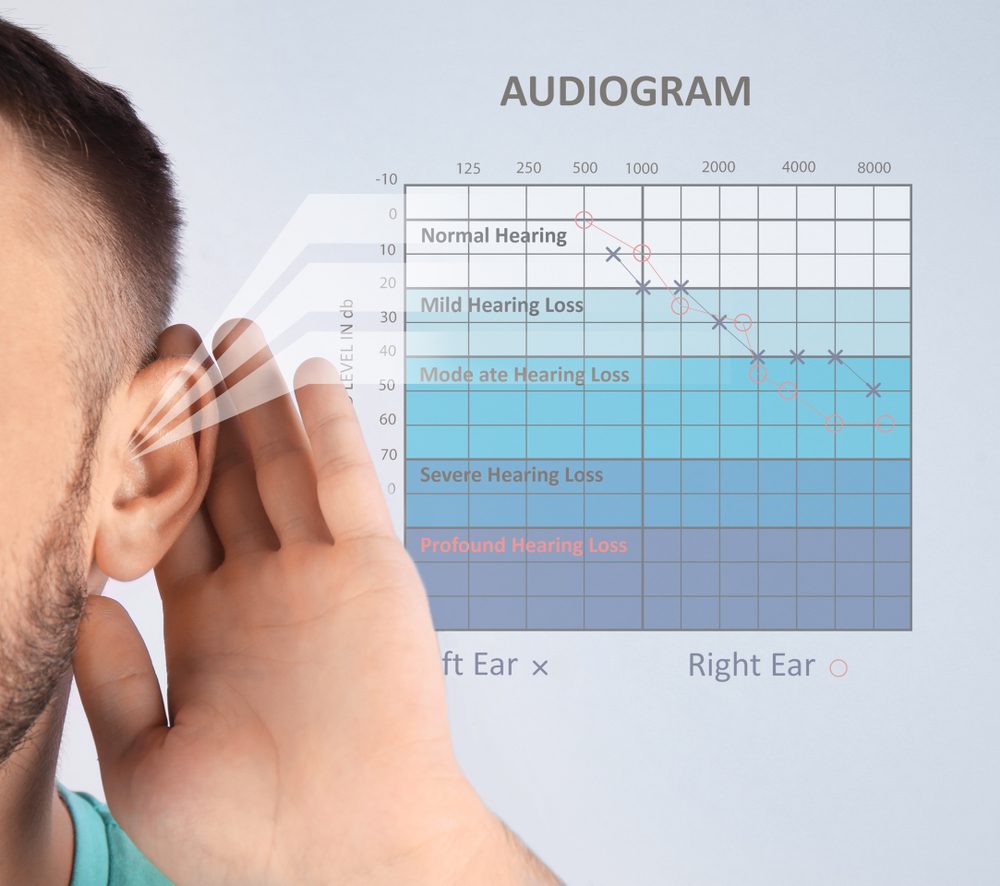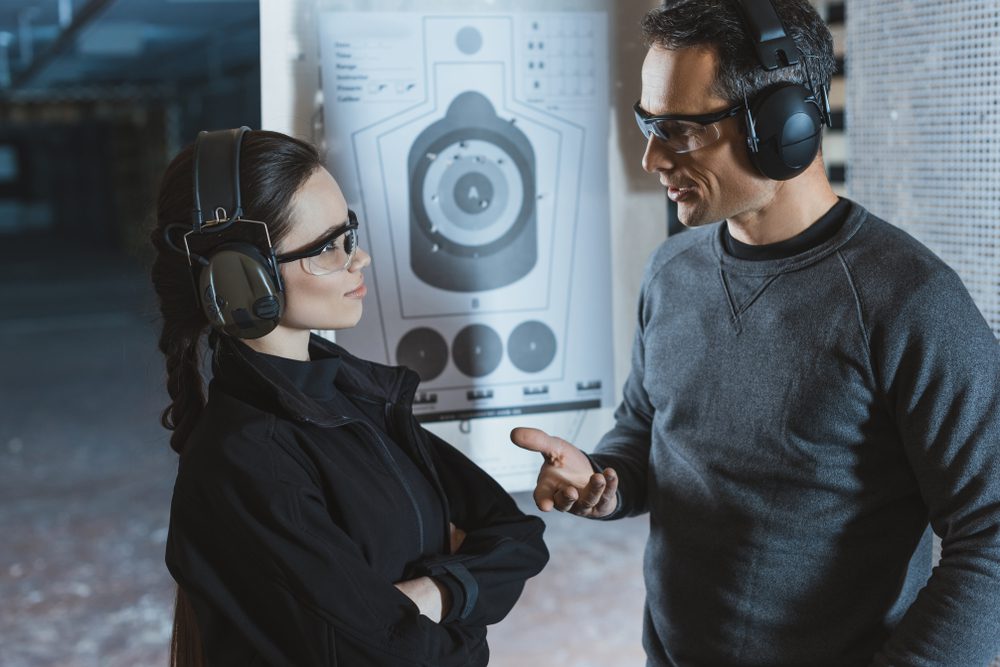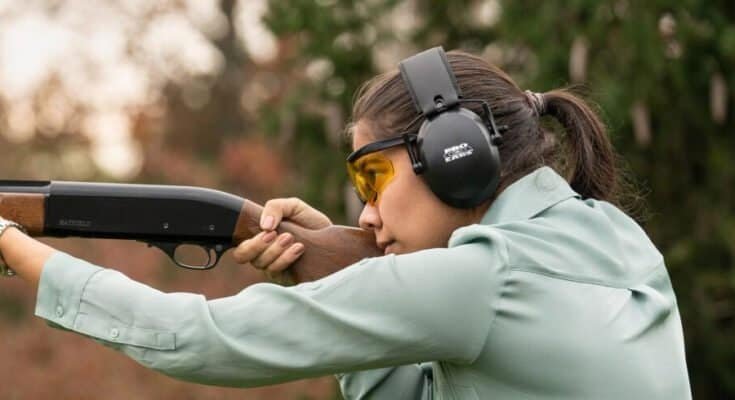Imagine you’re out at the shooting range, feeling the adrenaline rush as you hold your firearm. It’s exhilarating, isn’t it?
But amidst the excitement, have you ever stopped to think about the impact that loud gunshots might have on your ears? You might not feel it immediately, but every time you pull that trigger without ear protection, you risk permanent damage to your hearing.
Your ears are precious, and once your hearing is gone, it’s gone for good. Protecting them isn’t just a recommendation; it’s an essential practice for every shooter. You’ll discover the compelling reasons why ear protection is a non-negotiable when it comes to shooting. Stay with us, and ensure that your love for shooting never comes at the cost of your hearing health.

Hearing Damage Risks
Firearm enthusiasts often overlook hearing protection. Shooting can lead to severe hearing damage. Gunshots produce sounds above 140 decibels. This is louder than a jet engine. Without ear protection, hearing loss is inevitable.
Understanding Decibel Levels
Gunshots are extremely loud. Normal conversations are around 60 decibels. Gunshots exceed 140 decibels. This level can cause instant hearing damage. Ear protection is crucial.
Permanent Hearing Loss
Exposure to loud sounds can lead to permanent hearing loss. Damage to the inner ear is irreversible. Protecting your ears can prevent lifelong hearing issues.
Tinnitus Risks
Tinnitus causes ringing in the ears. It can result from loud noise exposure. Shooting without protection increases tinnitus risk. This condition can be bothersome and persistent.
Reduced Hearing Ability
Regular shooting can reduce your hearing ability. Loud noise exposure can affect how you hear everyday sounds. Ear protection helps maintain your hearing quality.
Preventing Ear Damage
Using ear protection safeguards against hearing damage. Earmuffs and earplugs reduce noise exposure. They protect your ears from harmful sound levels.
Types Of Ear Protection
When you’re at the shooting range or hunting in the great outdoors, ear protection might not be the first thing on your mind. However, it’s crucial for preserving your hearing. The sound of a firearm can reach levels that can cause immediate and permanent hearing damage. Luckily, there are several types of ear protection available to keep your ears safe.
Earplugs
Earplugs are small, affordable, and easy to carry. They’re perfect for those who value convenience. You can find them in foam, silicone, or custom-molded versions. Foam earplugs expand in your ear, blocking out noise effectively. Silicone earplugs offer a reusable option, which is great for multiple uses. If you want the best fit and maximum protection, custom-molded earplugs are worth considering. Have you ever found yourself in a situation where the noise was unbearable? Earplugs can be your trusty companion in these moments.
Earmuffs
Earmuffs cover the entire ear and are usually adjustable for comfort. They provide a higher level of protection than earplugs. You can easily slip them on and off, making them ideal for intermittent use. Some models come with padded headbands for added comfort. Picture this: you’re at the range, and the person next to you starts firing repeatedly. Earmuffs can be your shield against the barrage of noise. Consider earmuffs if you want reliable and straightforward ear protection.
Electronic Hearing Protection
Electronic hearing protection offers advanced features like sound amplification and noise cancellation. They allow you to hear conversations while blocking out harmful noises like gunshots. These are perfect for hunters who need to stay alert to their surroundings. Imagine hearing a rustle in the bushes while keeping your ears safe from sudden loud sounds. This type of protection combines safety with convenience. Have you ever wished you could hear everything while still being safe? Electronic hearing protection can make that wish come true.
Your choice of ear protection can make a significant difference in your shooting experience. Consider what works best for you and ensure your hearing is safeguarded. What type of ear protection will you choose next time you’re at the range or in the field?
Comparing Protection Levels
Ear protection is essential when shooting a firearm to prevent hearing loss from loud gunshots. Comparing protection levels helps you choose the right gear, like earmuffs or earplugs, to safeguard your ears effectively. Protecting your hearing ensures safety and enjoyment in shooting activities.
When you’re out on the shooting range, ear protection might not be the first thing you think about. Yet, it should be a priority. Understanding the different levels of ear protection can make a significant difference to your hearing health. Let’s dive into how various options stack up against each other in safeguarding your ears.Understanding Noise Reduction Rating (nrr)
The Noise Reduction Rating (NRR) is a crucial element when selecting ear protection. It measures how much sound the ear protection can block out. You might notice that higher NRR values indicate better protection, which is essential when considering the loudness of gunfire. Have you ever wondered why your ears ring after shooting without protection? It’s because firearms can produce noise levels over 140 decibels. A good ear protection device should have an NRR of at least 25 to 33 to effectively reduce this noise.Comparing Earplugs And Earmuffs
Earplugs and earmuffs offer different levels of protection. Earplugs fit directly into the ear canal and are often more portable and convenient. They can be a great choice if you’re wearing other protective gear like helmets. Earmuffs, on the other hand, cover the entire ear and can provide a higher level of protection due to their larger surface area. If you’re looking for maximum noise reduction, combining earmuffs with earplugs can be incredibly effective.Electronic Vs. Non-electronic Options
Electronic ear protection has gained popularity for its ability to block harmful noise while allowing you to hear normal conversations. This feature is especially useful on shooting ranges where communication is key. You can chat with your friends without removing your protection. Non-electronic options, while more affordable, might not offer this level of convenience. However, they still provide ample protection when used correctly. Have you ever tried both? You might find that the added cost of electronic earmuffs is worth the investment for the enhanced experience.Custom Vs. Standard Fits
Custom ear protection can offer a tailored fit, ensuring maximum comfort and effectiveness. If you shoot regularly, investing in custom molds might be beneficial. They fit snugly and won’t cause discomfort during long shooting sessions. Standard fits are more accessible and often cheaper, but they might not provide the same level of comfort. Ever felt your earplugs slip out during a session? A custom fit could solve that problem, offering peace of mind and consistent protection. Choosing the right ear protection is about balancing comfort, convenience, and effectiveness. What’s your priority when selecting ear protection? With a clearer understanding of your options, you can make an informed decision that best suits your shooting needs.Choosing The Right Protection
Wearing ear protection while shooting is essential. But not all ear protection is equal. Choosing the right ear protection ensures safety and comfort. It also optimizes your shooting experience. The wrong choice can lead to discomfort or inadequate noise reduction. So, understanding key factors helps in making an informed decision.
Comfort And Fit
Comfort is crucial when selecting ear protection. Uncomfortable gear can distract you. This can affect your focus and performance. Look for a design that feels good for long periods. Fit also plays a vital role. Poorly fitting protection may not seal well. This reduces its effectiveness against loud noises.
Noise Reduction Rating
The Noise Reduction Rating (NRR) is a key factor. It measures how well ear protection reduces noise. A higher NRR means better protection against loud sounds. Choose a product with a high NRR for effective noise reduction. This ensures your ears are shielded from the gunshot’s loud impact. Always check the NRR before buying ear protection. It’s a crucial step for your safety.
Benefits Of Ear Protection
Using ear protection while shooting firearms is crucial for preserving hearing. The loud noise from a gunshot can cause permanent ear damage. Ear protection provides several benefits, ensuring safety and comfort. Let’s explore the key advantages of using ear protection.
1. Reduced Risk Of Hearing Loss
Gunshots can be as loud as 140 decibels. This level of noise can damage ears instantly. Ear protection can significantly reduce this risk. Protecting your ears helps maintain your hearing for life.
2. Enhanced Focus And Concentration
Noise can be distracting. With ear protection, shooters can focus better. It blocks unnecessary noise, helping improve concentration. Better focus leads to better performance.
3. Increased Comfort During Shooting Sessions
Shooting without protection can be uncomfortable. Loud noises can cause stress and anxiety. Ear protection makes shooting sessions more enjoyable. Comfortable shooters perform better.
4. Prevention Of Tinnitus
Tinnitus is a ringing sound in the ears. It often results from loud noise exposure. Using ear protection can prevent this condition. Protecting ears keeps them healthy.
5. Better Communication On The Range
Some ear protection allows clear communication. It filters harmful noises while letting you hear voices. This feature is useful on shooting ranges. It ensures safety and coordination among shooters.
6. Adaptability To Different Environments
Ear protection comes in various forms. Options suit different environments and preferences. From earmuffs to earplugs, choices are available. Each type offers unique benefits for different shooting needs.

Common Myths
Ear protection is often overlooked during shooting. Many believe they don’t need it. These myths can lead to hearing damage. It’s important to debunk these misconceptions. Protect your ears and shoot safely.
Myth: My Ears Will Get Used To The Noise
Some think ears adapt to loud sounds over time. This is untrue. Constant exposure to gunfire can harm hearing. It doesn’t get easier for your ears. Protect them every time.
Myth: Ear Protection Reduces Awareness
People fear they won’t hear important sounds. Quality ear protectors filter harmful noise. They let you hear essential sounds. Stay aware and safe while shooting.
Myth: Only Loud Guns Need Ear Protection
Even small firearms can damage ears. It’s not just about the loudest guns. Any gunfire can be harmful. Always wear ear protection, regardless of gun size.
Myth: I Don’t Shoot Often Enough
Even occasional shooting can cause hearing loss. Every session matters for your ears. Protect them each time you shoot. Don’t wait for problems to start.
Myth: Ear Protection Is Uncomfortable
Modern ear protectors are designed for comfort. Many options exist to fit your needs. Choose the right type for you. Comfort and safety go hand in hand.
Maintenance And Care
Using ear protection when shooting a firearm is crucial not only for safety but also for maintaining the longevity and effectiveness of your protective gear. Proper maintenance and care can make all the difference in ensuring your ear protection continues to shield you from harmful noise levels. Let’s dive into how you can maintain and care for your ear protection gear.
How To Clean Your Ear Protection
Keeping your ear protection clean is vital. Dust, sweat, and other residues can accumulate, affecting performance. Regularly wipe down earmuffs with a damp cloth and mild soap. This simple habit ensures they’re always ready for action.
If you use earplugs, consider washing them gently with warm water and soap. Be sure to let them dry completely before your next use. It’s quick, easy, and keeps them fresh and effective.
Inspect For Wear And Tear
Ear protection gear can suffer from wear and tear, especially if used frequently. Check earmuff cushions for cracks or hardening. This can reduce their ability to block sound effectively.
Examine earplugs for any signs of deformation. If they don’t fit snugly anymore, it might be time for a replacement. A proper fit ensures optimal protection.
Storage Tips For Longevity
Proper storage can extend the life of your ear protection gear. Store them in a cool, dry place to prevent damage from moisture or heat. This simple step can prevent unexpected deterioration.
A personal story: I once left my earmuffs in the car on a hot day, and they were never the same. I learned the hard way that heat can warp the material. Keep your gear safe from extreme conditions.
When To Replace Your Ear Protection
Even with the best care, ear protection gear won’t last forever. Consider replacing earmuffs every few years or when they no longer seal properly. This ensures you maintain optimal hearing protection.
Think about earplugs as well. If they become discolored or lose their elasticity, it’s time for new ones. Your hearing health is worth the investment.
Why Regular Maintenance Matters
Regular maintenance isn’t just about keeping your gear clean—it’s about preserving your hearing. Neglecting ear protection can lead to ineffective noise reduction. Are you willing to risk your hearing for something preventable?
By caring for your ear protection, you not only prolong its life but also protect your own. It’s a small effort that makes a big difference.

Frequently Asked Questions
Why Is Ear Protection Necessary When Shooting?
Ear protection is crucial when shooting to prevent hearing damage. Firearms produce loud noises that can harm your ears. Over time, exposure to gunshot sounds can lead to hearing loss or tinnitus. Wearing ear protection safeguards your hearing health and enhances shooting experience.
Can Shooting Cause Permanent Hearing Loss?
Yes, shooting can cause permanent hearing loss. Gunshots emit high-decibel sounds that can damage inner ear structures. Without proper protection, repeated exposure to these sounds increases the risk of irreversible hearing loss. Using ear protection minimizes this risk, preserving your hearing for the future.
What Types Of Ear Protection Are Best?
The best ear protection options include earplugs and earmuffs. Earplugs are compact and block noise effectively. Earmuffs cover the ears, offering superior noise reduction. Combining both methods enhances protection, especially in loud shooting environments. Choose protection that comfortably fits and meets noise reduction standards.
How Can Ear Protection Improve Shooting Focus?
Ear protection improves shooting focus by reducing distracting noises. Gunshots and environmental sounds can disrupt concentration, affecting accuracy. With ear protection, shooters experience less auditory disturbance, allowing better focus on aiming and technique. This leads to improved performance and a more enjoyable shooting experience.
Conclusion
Ear protection is crucial when shooting firearms. It shields your ears from harm. Noise levels from guns can cause long-term hearing damage. Protecting your hearing ensures you enjoy shooting safely. Earplugs or earmuffs are simple and effective options. They help prevent ringing in your ears after shooting.
Choosing the right protection keeps your ears safe. Remember, once hearing is lost, it can’t be restored. Prioritize your hearing health. Make ear protection a habit every time you shoot. Your ears will thank you. Stay safe and enjoy your shooting activities responsibly.



